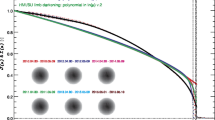Abstract
The method of moments and the direct fitting method are the onlyspectroscopic methods of mode identification which allow a determination ofall pulsational parameters. The pulsation parameters are required to predictthe light amplitude and phase which can be important discriminants in modeidentification. The direct fitting method has several advantages over themethod of moments. It is not restricted to low spherical harmonic degree or form of the eigenfunction and is not sensitive to the placement of the continuum. In the last few years the method has been applied to several different types of stars. We briefly describe the method and give someexamples of its application.
Similar content being viewed by others
References
Aerts, C., De Pauw, M. and Waelkens, C.: 1992, A&A 266, 294.
Balona, L.A. and Stobie, R.S.: 1980, MNRAS 190, 931.
Balona, L.A.: 1987, MNRAS 224, 41.
Balona, L.A. and Kambe, E.: 1999, MNRAS 308, 1117.
Balona, L.A.: 2000, in: M. Breger and M.H. Montgomery (eds.), Delta Scuti and Related Stars, A.S.P. Conf. Ser. 210, 170.
Balona, L.A. et al.: 2001, MNRAS 321, 239.
Balona, L.A., James, D.J., Motsoasele, P., Nombexeza, B., Ramnath, A. and van Dyk, J.: 2002, MNRAS 333, 952.
Author information
Authors and Affiliations
Rights and permissions
About this article
Cite this article
Balona, L.A. Mode Identification from Line Profiles using the Direct Fitting Technique. Astrophysics and Space Science 284, 121–124 (2003). https://doi.org/10.1023/A:1023206728369
Issue Date:
DOI: https://doi.org/10.1023/A:1023206728369



